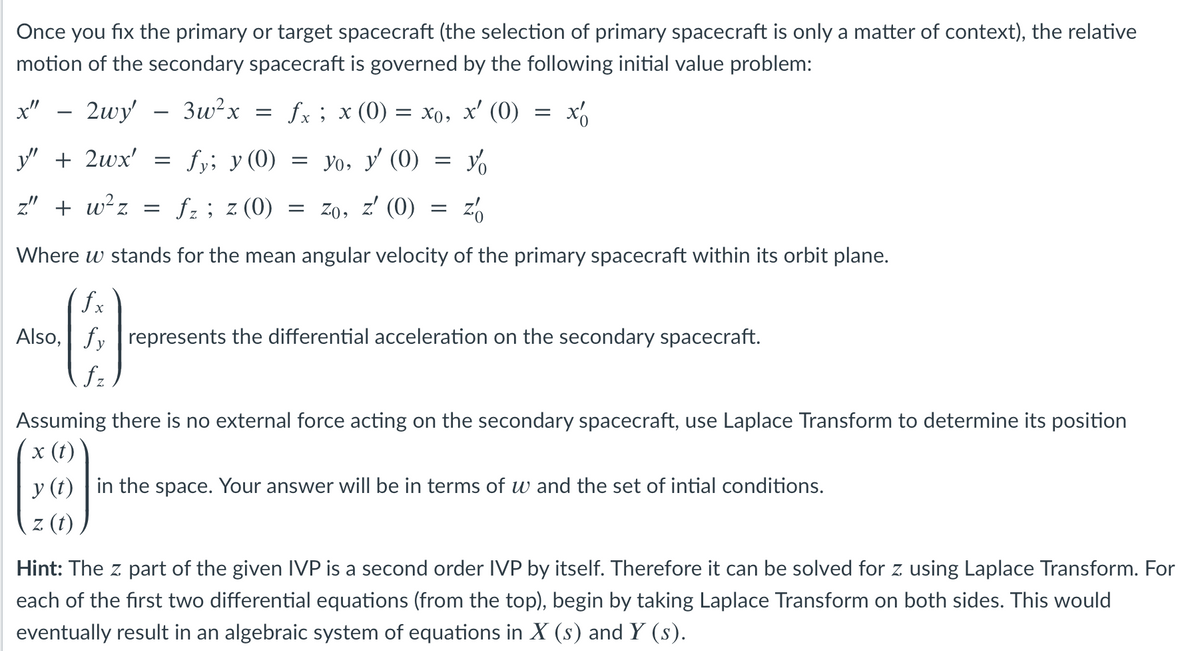Once you fix the primary or target spacecraft (the selection of primary spacecraft is only a matter of context), the relative motion of the secondary spacecraft is governed by the following initial value problem: - 2wy 3w²x fr; x (0) 3D хо, х' (0) y" + 2wx' fy; y (0) 3 Уо, У (0) z" + w²z fz ; z (0) = Z0, z' (0) Where w stands for the mean angular velocity of the primary spacecraft within its orbit plane. (fx fy represents the differential acceleration on the secondary spacecraft. Also, Assuming there is no external force acting on the secondary spacecraft, use Laplace Transform to determine its position х (1) y (t) | in the space. Your answer will be in terms of w and the set of intial conditions. z (t) Hint: The z part of the given IVP is a second order IVP by itself. Therefore it can be solved for z using Laplace Transform. For each of the first two differential equations (from the top), begin by taking Laplace Transform on both sides. This would eventually result in an algebraic system of equations in X (s) and Y (s).
Once you fix the primary or target spacecraft (the selection of primary spacecraft is only a matter of context), the relative motion of the secondary spacecraft is governed by the following initial value problem: - 2wy 3w²x fr; x (0) 3D хо, х' (0) y" + 2wx' fy; y (0) 3 Уо, У (0) z" + w²z fz ; z (0) = Z0, z' (0) Where w stands for the mean angular velocity of the primary spacecraft within its orbit plane. (fx fy represents the differential acceleration on the secondary spacecraft. Also, Assuming there is no external force acting on the secondary spacecraft, use Laplace Transform to determine its position х (1) y (t) | in the space. Your answer will be in terms of w and the set of intial conditions. z (t) Hint: The z part of the given IVP is a second order IVP by itself. Therefore it can be solved for z using Laplace Transform. For each of the first two differential equations (from the top), begin by taking Laplace Transform on both sides. This would eventually result in an algebraic system of equations in X (s) and Y (s).
Related questions
Question
Once you fix the primary or target spacecraft (the selection of primary spacecraft is only a matter of context), the relative motion of the secondary spacecraft is governed by the following initial value problem:

Transcribed Image Text:Once you fix the primary or target spacecraft (the selection of primary spacecraft is only a matter of context), the relative
motion of the secondary spacecraft is governed by the following initial value problem:
x" – 2wy' – 3w²x
fx ; x (0)
— Хо, х' (0)
-
-
y" + 2wx'
fy; y (0)
= yo, y' (0)
z" + w²z =
(0) z : ?f
= Zo, z' (0)
Where w stands for the mean angular velocity of the primary spacecraft within its orbit plane.
fx
Also, fy represents the differential acceleration on the secondary spacecraft.
fz
Assuming there is no external force acting on the secondary spacecraft, use Laplace Transform to determine its position
х (()
y (t) | in the space. Your answer will be in terms of w and the set of intial conditions.
z (t)
Hint: The z part of the given IVP is a second order IVP by itself. Therefore it can be solved for z using Laplace Transform. For
each of the first two differential equations (from the top), begin by taking Laplace Transform on both sides. This would
eventually result in an algebraic system of equations in X (s) and Y (s).
Expert Solution
This question has been solved!
Explore an expertly crafted, step-by-step solution for a thorough understanding of key concepts.
This is a popular solution!
Trending now
This is a popular solution!
Step by step
Solved in 3 steps
